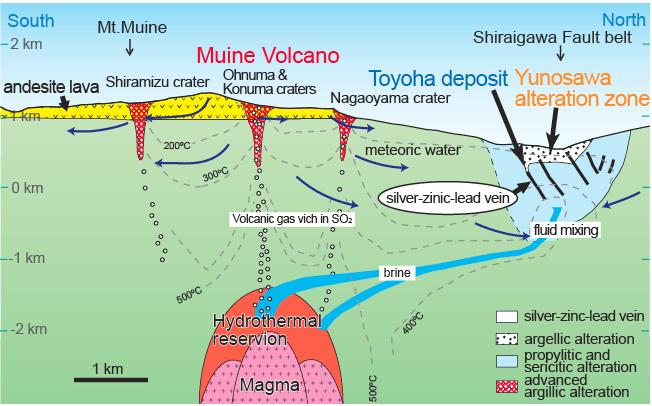
Volcanic activities and the accumulation and deposition of metal elements are closely related as seen in the gold deposition on the summit of Osorezan in Aomori Prefecture because the magma that forms a volcano contains metal elements. However, surprisingly little is known about the processes required for the metal elements in magma to form a deposit. Deposits are not often found near volcanoes remaining in the original form because the metal deposits are formed at depths of hundreds to thousands of meters beneath the surface. Instead, many deposits have been exploited near volcanoes which have lost their original form due to erosion. Not all volcanoes have metal deposits; in fact volcanoes with a deposit are extremely rare. Mt. Muine, the highest peak in Sapporo city in Hokkaido, (see Photo) was formed by the eruption of andesite lavas approximately three million years ago. Silver, indium, zinc, lead, and copper are being mined at the Toyoha deposit in the north. Even now, the temperature of the host rocks of the underground tunnels at the Toyoha deposit is as high as 100?C or higher, which indicates that not much time has passed since the metalliterous veins were formed. Therefore, this is a good example to study how metalliterous veins are formed.
We designed a model of the magma-hydrothermal system as mentioned below based on the surveys and investigations on ground surfaces and the undergroud (see Figure). After the eruption of lavas at Mt. Muine volcano, magma and hydrothermal fluid accumulated at a greater depth, two kilometers below the mountaintop. The hydrothermal fluid separated into hot volcanic gases and brine. Volcanic gases abundant in SO2 ascended and reacted with the andesite around the volcanic craters to form advanced argillic rocks made of alunite and cristabalite. Meanwhile, the brine, dissolving large amounts of base metal elements including silver, zinc, and lead, flowed toward the outside, separately from the volcanic gases due to its high density. The brine ascended the fault belt and mixed with meteric water that penetrated from the surface after flowing approximately three kilometers northward. It then precipitated into quartz and metal-sulfide minerals such as pyrite and sphalerite as veins. At the same time, it caused propylitic and sericitic alteration around the veins, turning them mostly into chlorite and illite. Then, after forming the veins, the remaining hot water ascended the faults and formed an argillic alteration zone mainly consisting of kaolinite. The zone is in Yunosawa, to the east of the deposit. These results provide us with indicators in our search for metal veins around volcanoes. Massive intrusion of magma immediately after the formation of a volcano is necessary for the formation of a metal deposit, and whether hydrothermal alteration zoes are developed or not is the key to the distinction. Furthermore, it is important to understand which part of a hydrothermal system developed by the magmatic intrusion you are observing by examining the combination and chemical composition of minerals in hydrothermally altered rocks in detail, and in which part you can expect the accumulation of metal elements by analyzing the geological structures.

Figure Section images of the Muine-Toyoha magmatic hydrothermal system